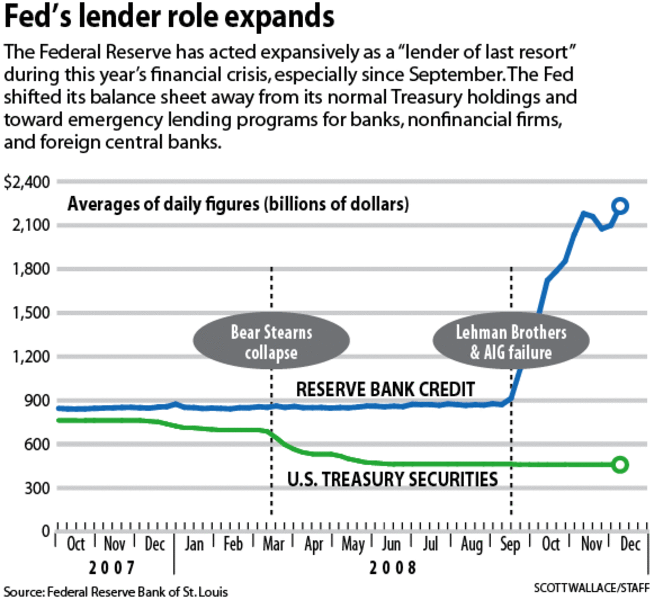Next move in Fed's most activist year
The Federal Reserve may cut its short-term interest rate below 1 percent Tuesday, stepping up a battle against recession that has already reached momentous proportions.
In fact, even before its last scheduled policy meeting of 2008, financial scholars say this stands as the central bank's most active year ever.
In its fight against a credit crisis, the Fed has slashed interest rates, participated in some of the largest single-firm rescues on record, and extended nearly $2 trillion in credit to firms both inside and outside the financial system.
After all that, the question remains: Will it be enough?
Many forecasters expect that the current recession will end sometime next year. But for now, the economy is losing jobs rapidly and stress in credit markets remains high.
The Fed probably has more work to do, and keeping interest rates low is just part of it.
"The Fed has been more active in this year than in any of its history," says Marvin Goodfriend, a central banking expert at Carnegie Mellon University in Pittsburgh. "There's no question that the Fed policy has cushioned the downturn to a huge extent."
Yet, he adds that ending the recession may be a job beyond even the Fed's large influence.
The reason is the unusual nature of this downturn. Mr. Goodfriend cites several features that are rare on their own, and highly unusual together: Severe credit turmoil, a global recession, and falling home prices that have reduced the net worth of many consumers.
Last week, a Fed survey found that household net worth fell 4.7 percent in the third quarter. In a sign of consumers adjusting to tighter credit, household debt declined for the first time in the survey's five-decade history.
In this setting, a rebound may hinge on broad government stimulus efforts, targeted programs designed to reduce home foreclosures, and efforts by private sector households and firms to regroup after years of expanding debt.
This doesn't mean the Fed's role will be unimportant, but its powers are constrained because it has already cut its interest rate to 1 percent.
Fed Chairman Ben Bernanke acknowledged as much in a speech earlier this month. "At this point the scope for using conventional interest-rate policies to support the economy is obviously limited," he said.
The federal funds rate, an overnight lending rate used by banks, hasn't been below 1 percent since the 1950s.
Mr. Bernanke said it was "feasible" that the Fed would shift its target for the rate below that level, and many forecasters are expecting just that on Tuesday.
Bernanke has voiced support for stimulus spending by Congress, and he recently called for new efforts to curb foreclosures and stabilize the housing market.
But the Fed itself is not entirely out of tricks.
Over time, a low federal-funds rate helps banks hit by rising defaults recover health. The policy widens the spread between their borrowing costs and what they earn by lending money. The central bank might pledge to keep its rate low for an extended period.
Also, the Fed can boost the money supply in the economy. The so-called monetary base has surged since September, as the Fed responded quickly to worries about corporate collapses on Wall Street and strapped consumers on Main Street.
Central banks are empowered to write unlimited checks. In this case, economists don't see expanding money supply as immediately inflationary, since it merely offsets slightly a decline in monetary "velocity" – the speed at which people in the economy use money.
Finally, the Fed can keep extending credit as a "lender of last resort." That's what it's been doing prodigiously in 2008.
In a succession of programs, the Fed has extended credit to commercial banks, securities dealers, and industrial firms that need buyers for their short-term debt.
All this has won the Fed mixed reviews. Economists generally support rate cuts and the role as lender of last resort. But the specifics leave lots of room for criticism from both liberals and conservatives.
Dean Baker, an economist at the liberal Center for Economic and Policy Research in Washington, is among those worried about a cozy relationship between the Fed and the banks it regulates – and now is bailing out. "They've been consistently behind the curve," responding to the recession, he adds.





